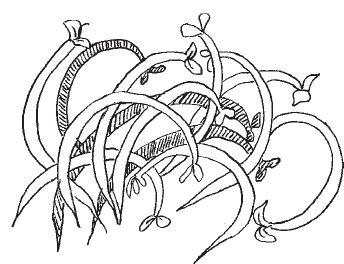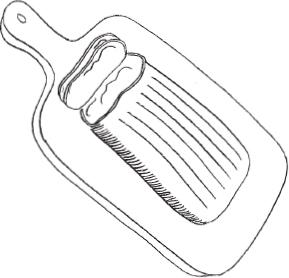Nourishing Traditions: The Cookbook That Challenges Politically Correct Nutrition and The... (117 page)
Authors: Sally Fallon,Pat Connolly,Phd. Mary G. Enig
Tags: #Non-Fiction, #Reference, #Science, #Health
It would be foolish to think that we could ever function without the elements of our world that shape and sustain us. Without an adequate supply of these essential nutrients, our very humanity disintegrates. Our brains would be dead if it weren't for the dynamic interplay of sodium and potassium ions across the membranes of our brain cells. These earth metals create waves of biological lightning that illuminate our nine billion miles of nerve fibers, allowing our inner galaxy of neurons to fully network.
Nutrients from the earth nourish our innate propensity toward wellness. Balances may shift, but harmony and health are the hallmarks of our existence. When all the elements are present, we are in touch with our true nature and can experience our birthright of health and vitality. John MacArthur
Life, Liberty, and the Pursuit of Wellness

ORIENTAL TUNA SALAD
Serves 4
1½ pounds fresh tuna, cut about 1-inch thick
sea salt and pepper
1 tablespoon olive oil
1-2 heads red or romaine lettuce
1 red pepper, seeded and cut into thin slices
1
/
3
cup
pickled ginger
, drained1 ¼ cup
Oriental dressing
Rub sea salt and pepper into tuna. In a heavy skillet, saute tuna in olive oil over a medium-high flame, about 5 minutes per side until just cooked through. Break up lettuce and toss with pepper, ginger and Oriental dressing. Divide salad between four large plates and place a serving of tuna on top of each. Serve immediately.
SWEETBREAD SALAD
Serves 6
2 pounds prepared veal sweetbreads (see
prepared sweetbreads
)1 cup unbleached flour
sea salt and pepper
3 tablespoons butter
3 tablespoons extra virgin olive oil
1 pound fresh asparagus, lightly steamed
6 cups baby lettuces or mixed greens, such as watercress or lamb's lettuce
2 ripe tomatoes, peeled, seeded and finely chopped
1 head Belgian endive, leaves separated
2 cups
creamy dressing
To peel tomatoes, see
Kitchen Tips and Hints
. Slice sweetbreads at
3
/
8
-inch intervals. Dredge in a mixture of flour, salt and pepper and saute in butter and olive oil. Mound greens in the center of individual serving plates and decorate edges with asparagus, chopped tomato and endive leaves. Place slices of warm, sauteed sweetbreads over greens and spoon dressing over.
"There is extensive scientific literature concerning the hazardous effects of direct microwave radiation of living systems. . .. It is astonishing therefore to realize how little effort has been taken to replace this detrimental technique of microwave cooking with technology more in accordance with nature. . .. Of all the natural substances—which are polar—the oxygen of water molecules reacts most sensitively. This is how microwave cooking heat is generated—friction from this violence in water molecules. Structures of molecules are torn apart, molecules are forcefully deformed, called structural isomerism, and thus become impaired in quality. This is contrary to conventional heating of food where heat transfers convectionally from without to within. Cooking by microwaves begins within the cells and molecules where water is present and where the energy is transformed into frictional heat." Dr. Hans Hertel quoted in
Search for Health

DELUXE FRENCH BEAN SALAD
Serves 6
1½ pounds cooked
French beans
, cut into 1-inch lengths3 heads Belgian endive, leaves separated
2 ripe tomatoes, peeled, seeded and finely chopped
6 slices duck and chicken liver mousse (
Duck and Chicken Liver Mousse
)1 cup
basic dressing
or
walnut dressingTo peel tomatoes, see
Kitchen Tips and Hints
. Arrange endive leaves around the edges of individual plates. Place a small amount of tomato on each leaf. Cut each triangle crouton in half, spread with mousse and arrange around the outside edge of the place, alternating with the endive leaves. Mix the beans with basic dressing or walnut dressing and mound in the center of each plate.

ORIENTAL RED MEAT SALAD
Serves 6
1½ pounds beef flank steak
½ cup lemon juice
6 tablespoons naturally fermented soy sauce
2 tablespoons extra virgin olive oil or expeller-expressed peanut oil
1 tablespoon toasted sesame oil
1 teaspoon freshly grated ginger
pinch of red pepper flakes
2 tablespoons toasted sesame seeds
½ pound snow peas, steamed lightly and cut into quarters at an angle
1 pound bean sprouts, lightly steamed
1 red pepper, seeded and cut into a julienne
Using a sharp knife, score the flank steak across the grain on both sides. Broil 3 or 4 minutes to a side or until meat is medium rare. Transfer to a cutting board and let stand for 10 minutes. Meanwhile, mix lemon juice, soy sauce, olive oil or peanut oil, sesame oil, ginger and red pepper flakes together. Cut the meat across the grain on an angle into very thin slices and cut these slices into a julienne. Marinate in the soy sauce mixture for several hours in refrigerator. Just before serving, toss with sesame seeds and vegetables.
In early June, Indian Harchand Singh collapsed in the middle of a busy London intersection. He cracked his skull, but even worse he awoke in the hospital to the news that he had suffered a serious heart attack. His cholesterol was normal and he ate a strict vegetarian diet. He was 38 years old.
This is not an unusual story for south Asians
, most of whom are vegetarians. The south Asians of India, Pakistan and Bangladesh have a 40 percent higher rate of heart disease than the British, who eat a great deal of every conceivable type of animal meat and fat. In Singapore, the rate of heart disease is
400 percent
higher than the local Chinese—who eat a lot of pork. William Campbell Douglass, MD
Second Opinion

DUCK BREAST SALAD WITH HAZELNUTS
Serves 4
2 duck breasts
¼ cup lemon juice
¼ cup extra virgin olive oil
6 cups baby lettuce or spinach
1 cup
basic dressing1 tablespoon hazelnut oil (See
Sources
)½ cup
crispy hazelnuts
, chopped
Trim excess fat off the duck breasts and score in a diamond pattern. Marinate several hours in mixture of lemon juice and olive oil. Pat dry and cook in a heavy skillet, several minutes to a side until medium rare. Transfer to a board and let stand 10 minutes. Slice thinly across the grain. Blend hazelnut oil with dressing and toss with salad and hazelnuts. Mound in the center of individual plates and place duck slices on top. Serve with
round croutons
.
. . ..The same violent friction and athermic deformations that can occur in our bodies when we are subjected to radar or microwaves happens to the molecules in the food cooked in a microwave oven. In fact, when anyone microwaves food the oven exerts a power input of about 1000 watts or more. This radiation results in destruction and deformation of molecules of food and in the formation of new compounds (called radiolytic compounds) unknown to man and nature. Today's established science and technology argues forcefully that microwaved food, and irradiated foods, do not have any significantly high "radiolytic compounds" than do broiled, baked or other conventionally cooked foods—but microwaving does produce more of these critters. Curiously, neither established science nor our ever protective government has conducted any tests of the effects of eating the various kinds of cooked foods on the blood of eaters. Dr. Hans Hertel did test it, and the indication is clear that something is amiss and larger studies should be funded. Tom Valentine
Search for Health